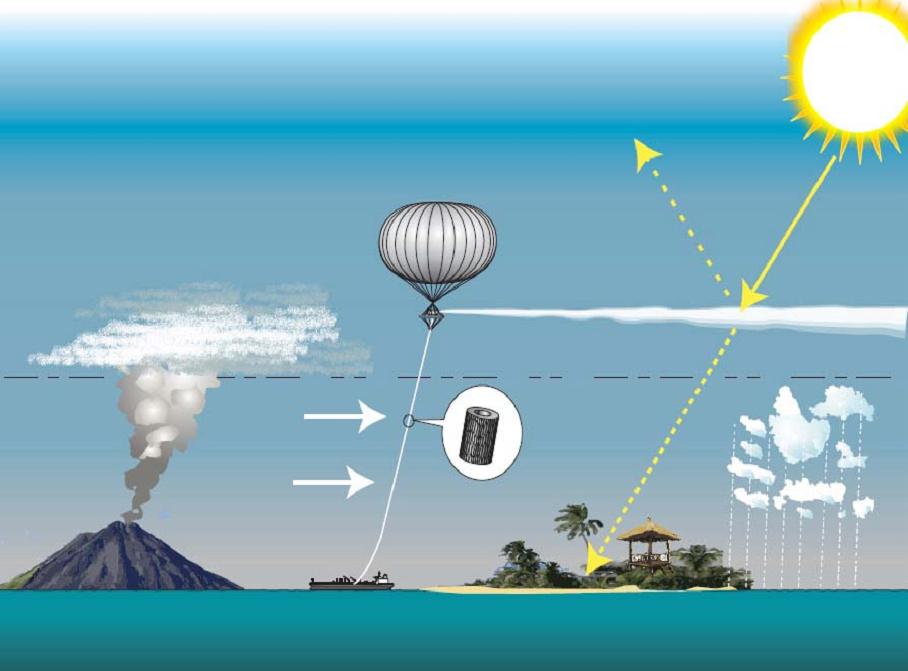A new report makes the case that the fossil fuel industry prefers geoengineering as an approach for addressing climate change because it allows the industry to keep arguing for continued fossil fuel use.
In Fuel to the Fire: How Geoengineering Threatens to Entrench Fossil Fuels and Accelerate the Climate Crisis, the Center for International Environmental Law (CEIL) warns that geoengineering, which includes technologies to remove huge amounts of carbon dioxide and to shoot particles into the atmosphere to block sunlight, potentially offers more of a problem for the climate than a solution.
“Our research shows that nearly all proposed geoengineering strategies fail a fundamental test: do they reduce emissions and help end our reliance on fossil fuels?” said CIEL President Carroll Muffett, who co-authored the report with the support of the Heinrich Boell Foundation.
If you’ve ever wondered about geoengineering, @ciel_tweets has a new report–you should definitely read it, and then you should get to work repowering our planet with renewable energy!https://t.co/XoRXOW73ap
— Bill McKibben (@billmckibben) February 13, 2019
The report’s title page features a quote from former ExxonMobil CEO (and former Secretary of State) Rex Tillerson that highlights the appeal of geoengineering to his industry:
“It’s an engineering problem, and it has engineering solutions … The fear factor that people want to throw out there to say we just have to stop this [burning fossil fuels], I do not accept.”
Inventing new technological solutions to deal with climate change has an obvious allure, and the mainstream media offers a steady flow of stories supporting this concept, but only according to the headlines.
This week The New York Times ran an in-depth story, “The Tiny Swiss Company That Thinks It Can Help Stop Climate Change.” It highlighted a start-up company working on removing carbon dioxide from the atmosphere — one of the main geoengineering strategies.
Two European entrepreneurs think they can remove carbon from the air at prices cheap enough to matter. Can their technology put a dent in climate change? https://t.co/16TZTjDT9x pic.twitter.com/60enD82jGT
— NYT Magazine (@NYTmag) February 13, 2019
However, like many of these stories, the hopeful headline doesn’t match reality. The technology touted currently has no way of being scaled up to a level where it could have an actual impact on the climate — and even if it were possible — would be decades away. Decades the world doesn’t have to wait.
In order to meet international targets to limit global warming, the world needs to dramatically reduce its fossil fuel consumption and fast, according to climate scientists. The fantasy of unproven technologies constituting the bulk of geoengineering approaches provides a lifeline for the fossil fuel industry to keep justifying its future in a warming world.
The Green New Deal movement, along with striking school children, an army of activists like Bill McKibben of 350, and increasing numbers of Democratic politicians are pushing the scientifically based message that in order to prevent catastrophic climate change, the world must begin transitioning away from fossil fuels now.
When Denial No Longer Works, Delay
While sowing doubt about climate science has been an effective public relations strategy for the fossil fuel industry for decades, public polling reveals that the majority of Americans agree that climate change is real and requires action. Reading the crowd, the fossil fuel industry might then be inclined to move to the next best approach: delaying the actions which represent an existential threat to it.
“For six decades oil companies have argued that climate change does not exist, that it’s not caused by human activity, and that if it is, it’s not a problem,” said Steven Feit, co-author of the CEIL report. “Now, these companies are claiming to accept that climate change is an engineering problem … Like their decades of denial, this action is profoundly dangerous.”
As the report notes, geoengineering focuses on modifying the global climate system via methods like removing carbon dioxide from the air or “dimming the sun” with solar radiation management. Regardless of the theoretical effectiveness of the various proposed methods within these categories, all facilitate continued fossil fuel use, something industry advocates openly acknoweldge.
Proposed solar radiation management using a tethered balloon to inject sulfate aerosols into the stratosphere. Credit: Hughhunt, CC BY–SA 3.0
This is a feature of the geoengineering approach, not a bug. One paper quoted in the report notes that the “main advantage of [carbon] sequestration is its compatibility with existing fossil fuel infrastructure.” Sequestration refers to the process of pulling carbon dioxide out of the atmosphere and storing it. (Currently, technological, rather than soil or plant-based, sequestration primarily takes the form of using carbon dioxide to pump more oil and gas out of existing wells.)
What geoengineering promises is that if humanity waits long enough, scientists and innovators will develop new technologies that allow us to burn fossil fuels and not impact the climate because we can just pull the carbon back out of the atmosphere. Or perhaps if that doesn’t work, we can just cool the Earth by injecting sunlight-reflecting particles into the atmosphere.
All geoengineering can offer right now, in 2019, is hope that continued use of fossil fuels might not lead to catastrophic climate change. But it does nothing to address the other ongoing environmental impacts that come with fossil fuel production and consumption.
Meanwhile, decarbonizing the global economy and ending the fossil fuel era, using technologies available and largely competitive today, will reduce the world’s climate risks to food, water, ecosystems, and human lives.
Focusing on Known Climate Solutions
The authors of the new CEIL report argue that current climate goals are achievable without relying on geoengineering but that any scenario for meeting them would “require an early, rapid phase-out of fossil fuels.”
The CEIL report bases this statement on a 2018 United Nations (UN) climate report. As DeSmog has reported, that report also found that to limit warming to 1.5°C (2.7°F), “all scenarios rely in some way on so-called Carbon Dioxide Removal technologies, such as afforestation, reforestation, soil carbon sequestration, and the largely untested and controversial BECCS — bioenergy with carbon capture and storage.”
In addition, the UN report noted carbon dioxide removal technologies “deployed at scale is unproven, and reliance on such technology is a major risk.”
It isn’t hard to see why the fossil fuel industry prefers approaches that don’t mean suddenly phasing it out. And while the CEIL authors admit that this approach is “ambitious,” they also say it is achievable. Geoengineering aside, authors of the UN report use similar language describing what it will take to reach international climate goals.
Princeton professor Stephen Pacala supports efforts to remove carbon dioxide but says he is realistic about doing this on a global scale, as he explained to The New York Times:
“The idea of bringing direct air capture [carbon dioxide removal] up to 10 billion tons by the middle or later part of the century is such a herculean task it would require an industrial scale-up the likes of which the world has never seen.”
A representation of the volume of one metric ton of carbon dioxide gas. Credit: Carbon Visuals, CC BY 2.0
Whether ending reliance on fossil fuels or designing a whole new global industry to remove carbon dioxide from the atmosphere, both would require a coordinated effort unlike any that has come before in the history of human civilization.
However, scientists know that no longer burning fossil fuels will benefit the climate and viable technologies for this energy transition already exist. As Pacala noted, “Wind and solar are now the cheapest forms of energy in the right locations.” That is quite convenient at a time when the world needs cheap, low-carbon energy sources.
On the other hand, betting the future on unproven geoengineering technologies which enable the fossil fuel industry to continue drilling, mining, burning, and profiting while contributing to climate change — this could also work. But as the CEIL report argues, this is a far riskier approach for the rest of human civilization — with a much lower chance of success.
Main image: Earth Credit: Rubén Moreno Montolíu, CC BY–SA 2.0
Subscribe to our newsletter
Stay up to date with DeSmog news and alerts








